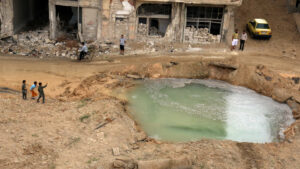Protests against the Syrian government have surged in intensity in the southern regions of the country, fueled by widespread discontent over the decision to cut fuel subsidies amidst hyperinflation and economic turmoil. These protests have taken on a significant symbolic dimension, epitomized by the burning of a large banner featuring Bashar al-Assad in Suweida’s central square. What began as an expression of frustration has now evolved into a broader movement demanding change and accountability.
**Growing Public Outcry:**
The video showcasing the burning of Bashar al-Assad’s banner serves as a striking visual representation of the growing public outrage against the government’s policies. The protests have not only been limited to Suweida; citizens from various cities across Syria have united to voice their discontent against worsening living conditions and economic distress.
**Chants for Change:**
A noteworthy aspect of the protests is the emergence of chants demanding the fall of Bashar al-Assad. These echoes of the 2011 pro-democracy uprising, which eventually spiraled into a devastating war, underscore the magnitude of dissatisfaction among the populace. Such fervent calls for change have been absent from the streets of Suweida for over a decade, making the current wave of dissent all the more significant.
**Challenging Assad’s Regime:**
Suweida, a government-held city with a majority Druze population, has traditionally experienced milder forms of dissent due to the regime’s cautious approach towards this minority community. However, the recent protests have defied expectations by introducing anti-Assad slogans to the streets of Suweida. This shift in sentiment suggests a departure from the government’s previous levels of tolerance for dissent in the area.
**Expanding Influence and Demands:**
Protests have not been confined to Suweida alone. Neighboring Deraa province, where the initial 2011 uprising originated, has also witnessed demonstrations. The catalyst for these intensified protests has been the government’s decision to remove fuel subsidies, exacerbating the already dire economic circumstances caused by hyperinflation. With almost 90% of the population living below the poverty line, the sudden surge in fuel prices has ignited widespread public discontent.
**Calls for Change and Future Prospects:**
A new movement named “The 10th of August Movement” has articulated demands for improved living conditions, a higher minimum wage, better electricity supply, passport issuance reforms, and the release of political prisoners. These demands, reflecting the aspirations of a populace grappling with economic hardships and limited prospects, resonate across various cities in Syria.
**Alawite Discontent and Its Implications:**
Criticism of Assad has even surfaced from within his own Alawite community, long considered his staunchest supporters. Some Alawite voices have expressed frustration with the government’s handling of the crisis and have been detained for doing so. While a well-organized movement against Assad is yet to take shape, the emergence of dissent within the Alawite heartland suggests the potential for larger shifts in the political landscape.
The burning of Bashar al-Assad’s banner in Suweida’s main square has transformed from a symbolic act into a powerful representation. The protests, now spreading across Syria, encapsulate a broader discontent with economic hardships and government policies. While the immediate fall of Assad seems likely, the sustained and expanding public outcry, including within his own Alawite community, underscores the potential for significant shifts in Syria’s political trajectory.


